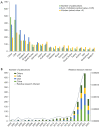International publication trends in the application of artificial intelligence in ophthalmology research: an updated bibliometric analysis
- PMID: 37007552
- PMCID: PMC10061466
- DOI: 10.21037/atm-22-3773
International publication trends in the application of artificial intelligence in ophthalmology research: an updated bibliometric analysis
Abstract
Background: The literature on artificial intelligence (AI)-related topics has been expanding rapidly over the last two decades, showing that AI is a crucial force in advancing ophthalmology. This analysis aims to provide a dynamic and longitudinal bibliometric analysis of AI-related ophthalmic papers.
Methods: The Web of Science was searched to retrieve papers regarding the application of AI in ophthalmology published in the English language up to May 2022. The variables were analyzed using Microsoft Excel 2019 and GraphPad Prism 9. Data visualization was performed using VOSviewer and CiteSpace.
Results: In this study, a total of 1,686 publications were analyzed. Recently, AI-related ophthalmology research has increased exponentially. China was the most productive country in this research field, with 483 articles, but the United States of America (446 publications) contributed most to the sum of citations and the H-index. The League of European Research Universities, Ting DSW, and Daniel SW were the most prolific institution and researchers. This field is primarily concerned with diabetic retinopathy (DR), glaucoma, optical coherence tomography, and the classification and diagnosis of fundus pictures. Current hotspots in AI research include deep learning, diagnosing and predicting systemic disorders by fundus images, incidence and progression of ocular diseases, and outcome prediction.
Conclusions: This analysis thoroughly reviews AI-related research in ophthalmology to help academics better comprehend the growth and possible practice consequences of AI. The association between eye and systemic biomarkers, telemedicine, real-world studies, and the development and application of new AI algorithms, such as visual converters, will continue to be research hotspots over the next few years.
Keywords: Artificial intelligence (AI); VOSviewer; bibliometrics; data visualization; ophthalmology.
2023 Annals of Translational Medicine. All rights reserved.
Conflict of interest statement
Conflicts of Interest: All authors have completed the ICMJE uniform disclosure form (available at https://atm.amegroups.com/article/view/10.21037/atm-22-3773/coif). The authors have no conflicts of interest to declare.
Figures






Comment in
-
New era after ChatGPT in ophthalmology: advances from data-based decision support to patient-centered generative artificial intelligence.Ann Transl Med. 2023 Aug 30;11(10):337. doi: 10.21037/atm-23-1598. Epub 2023 Jun 30. Ann Transl Med. 2023. PMID: 37675304 Free PMC article. No abstract available.
References
Publication types
LinkOut - more resources
Full Text Sources
